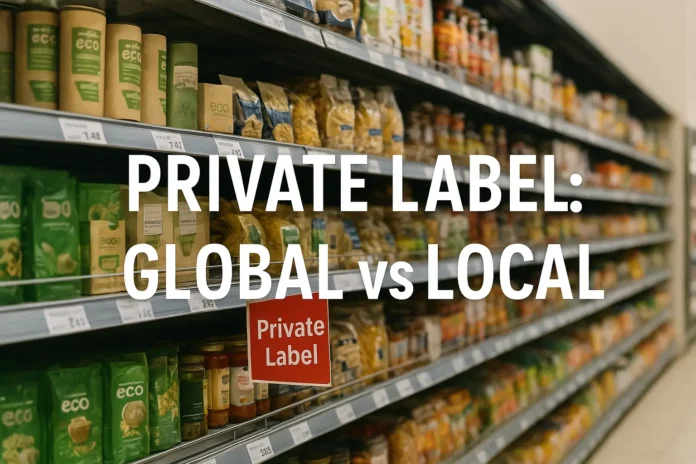Private label is no longer a second-rate choice. It’s proving to be a growth engine, a branding tool, and in many cases, the preferred option. But how private label works varies a lot depending on where you are. That tension between global scale and local flavor is what makes the story so interesting—and powerful.
Europe: Where Trust Meets Premium
Two Faces of Private Label
In much of Europe, private label isn’t just competing—it’s leading. In the UK, Switzerland, Spain, the Netherlands and beyond, private labels now command over 40–50% of grocery sales. In the UK alone, it’s above 50%. That’s no longer value-led volume; it’s about quality and trust.
Why It Works
Premium tiers: Retailers offer sub-brands—like Tesco’s Finest, Carrefour’s Selection, Aldi’s Specially Selected—so own-brand choices can feel as luxurious as national ones.
Trusted by shoppers: Many people believe their local supermarket cares more about quality than big-name brands. Stores are part of the community; they feel accountable.
Green credentials: Europe pushes strict rules on eco-friendly packaging, fair sourcing, and labeling. Private labels often lead with sustainable versions.
Retailers still see growth ahead. Even though expansion has slowed from nearly 12% to around 4%, private label share across Europe keeps edging up as stores cement their premium appeal.
United States: Value, Scale, and Rapid Innovation
Winning on Price—and Quality
In the US, the private label world is still synonymous with value, but things have evolved. Now, it’s about size and trust, not just lower price.
Costco has made Kirkland into a powerful brand that people actively seek out.
Walmart’s Great Value and Target’s Good & Gather deliver reliability at lower cost, especially with bulk options for families.
On average, store-brand products are still around two dollars cheaper than brand names—big savings in a weekly shop.
Smart Moves
Tiered offerings: Retailers expand into both budget and premium ranges to match different shoppers.
Tariff defense: With global trade pressures pushing up costs, private label helps retailers control prices and supply chains.
Trust gap closing: Surveys show most American shoppers now trust store brands, especially those from retailers they already use.
Still, experts note that private label growth in the U.S. depends on continued innovation, not just low prices.
Asia: Local Flavor, Agile Strategies
Tailored to Taste
Asia’s private label game isn’t about a single template. Instead, it’s hyper-local—built for regional charm.
India and Southeast Asia: Spice blends, rice varieties, or oil formats tuned to local kitchens.
East Asia: In Japan and Korea, private label extends into beauty, wellness, and pet care—not just food.
China and e-commerce: Platforms like Freshippo shape their own-brand ranges using real-time shopper data.
Why It Matters
Private label share in Asia isn’t massive—yet—but it’s growing fast. The local approach works because it connects directly with consumer preferences and cultural tastes.
Beyond Geography: Global Forces at Work
Private Label Growth Continues
Globally, most consumers now see private label as a good alternative.
Over half of shoppers say they’re buying more store brands today than a year ago.
Many would buy even more if there were broader choices, fresher assortments, and more innovative options.
Consumers are demanding quality, innovation, and sustainability together—not just cheap products.
Innovation Trends to Watch
Omnichannel shopping: Shoppers expect consistency across store, app, and online. Data helps retailers make private labels feel seamless across channels.
Smart packaging: QR codes, digital storytelling, and interactive labels help private label products stand out.
Sustainability: From refillable packaging to eco sourcing, store brands are often quicker to test green formats.
Data and AI: Predictive tools help supermarkets launch new products faster, keeping ranges fresh and relevant.
The Summary: Private Label’s Strength Lies in Its Flexibility
| Region | Core Strategy | What Works |
|---|---|---|
| Europe | Trust + Premium | High share, sustainability, luxury tiers |
| USA | Value + Scale | Cost savings, bulk formats, tariff buffer |
| Asia | Localisation + Adaptation | Tailored recipes, formats, new categories |
| Global | Innovation + Omnichannel | AI, smart labeling, digital presence |
The real power of private label lies in using a global structure to deliver local relevance. Retailers who succeed mix scale with customization—giving consumers what they want, how they want it, wherever they shop.
Final Thought
Private label used to be the “no-name fallback.” Today, it’s where strategy, data, and local insight meet. Whether premium in Europe, savvy value in the U.S., or culturally tuned in Asia—private labels are rewriting retail.



